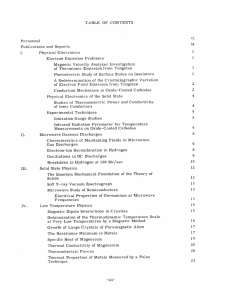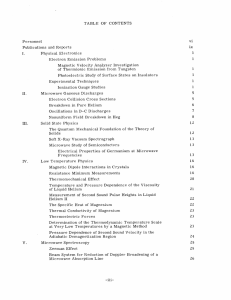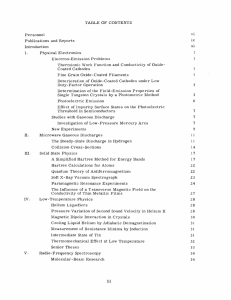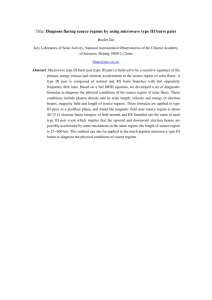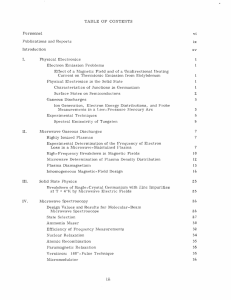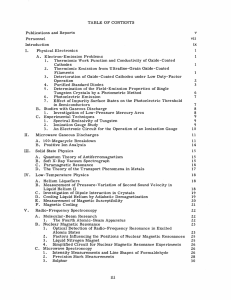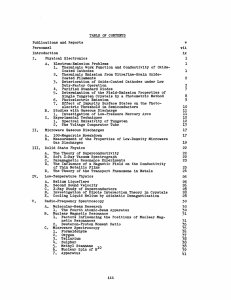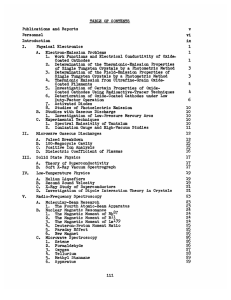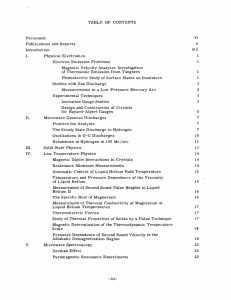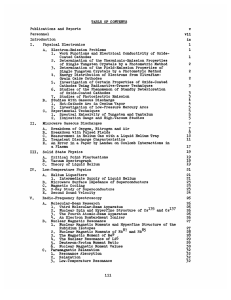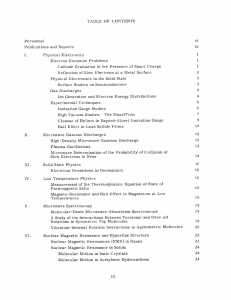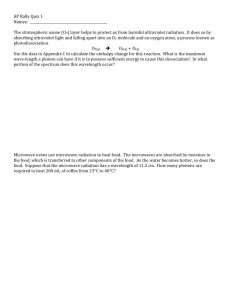TABLE OF CONTENTS vi Personnel ix
advertisement
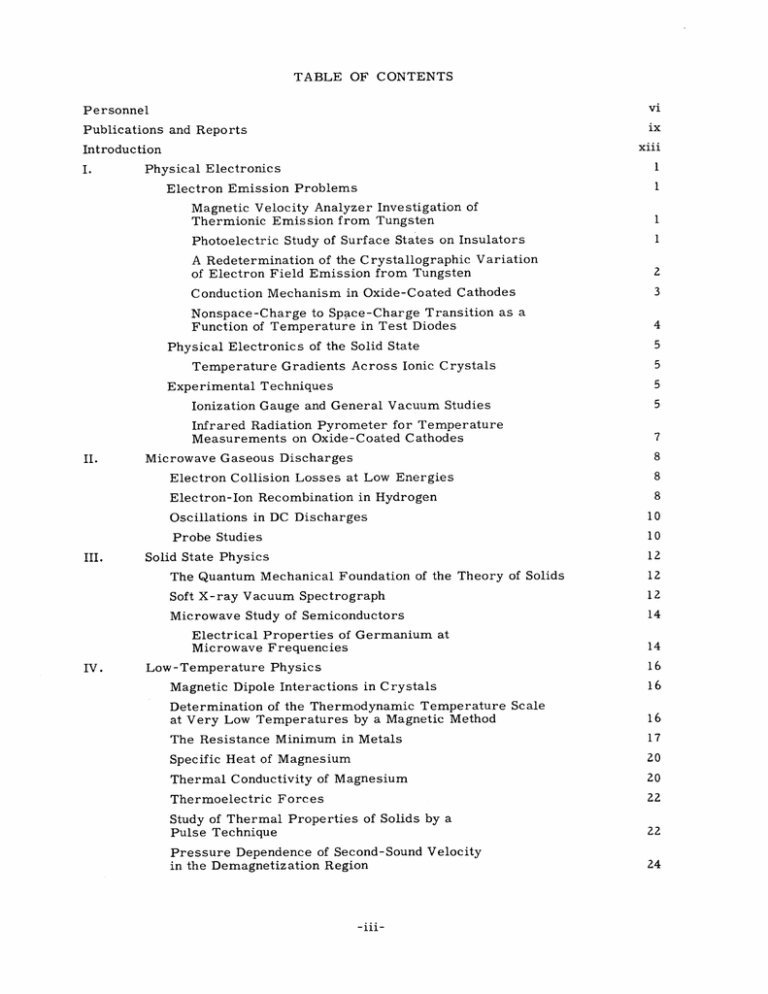
TABLE OF CONTENTS Personnel vi Publications and Reports ix xiii Introduction I. 1 Physical Electronics 1 Electron Emission Problems Magnetic Velocity Analyzer Investigation of Thermionic Emission from Tungsten 1 Photoelectric Study of Surface States on Insulators 1 A Redetermination of the Crystallographic Variation of Electron Field Emission from Tungsten 2 Conduction Mechanism in Oxide-Coated Cathodes 3 Nonspace-Charge to Space-Charge Transition as a Function of Temperature in Test Diodes 4 Physical Electronics of the Solid State Temperature Gradients Across Ionic Crystals III. Ionization Gauge and General Vacuum Studies 5 Infrared Radiation Pyrometer for Temperature Measurements on Oxide-Coated Cathodes 7 8 Microwave Gaseous Discharges Electron Collision Losses at Low Energies 8 Electron-Ion Recombination in Hydrogen 8 Oscillations in DC Discharges 10 Probe Studies 10 12 Solid State Physics The Quantum Mechanical Foundation of the Theory of Solids 12 Soft X-ray Vacuum Spectrograph 12 Microwave Study of Semiconductors 14 Electrical Properties of Germanium at Microwave Frequencies IV. 5 5 Experimental Techniques II. 5 14 16 Low-Temperature Physics Magnetic Dipole Interactions in Crystals 16 Determination of the Thermodynamic Temperature Scale at Very Low Temperatures by a Magnetic Method 16 The Resistance Minimum in Metals 17 Specific Heat of Magnesium 20 Thermal Conductivity of Magnesium 20 Thermoelectric Forces 22 Study of Thermal Properties of Solids by a Pulse Technique 22 Pressure Dependence of Second-Sound Velocity in the Demagnetization Region 24 -iii- V. VI. Second-Sound Pulse Amplitudes in Liquid Helium II 24 Thermomechanical Effect 25 Viscosity of Liquid Helium 26 27 Microwave Spectroscopy Zeeman Effect 27 High-Temperature Microwave Spectroscopy 28 Water Molecule 28 30 Molecular Beam Research 30 C136 Experiment 1 34 The Hyperfine Structure of Cs VII. 31 Mass Spectrometer Problem 31 Use of a Directional Oven 31 Experimental Procedure 32 A Detector for Radioactive Atomic Beams 33 An Ionic Beam Magnetic Resonance Method 33 36 Magnet Laboratory Research 36 Nuclear Magnetic Resonances Nuclear Resonances in Gases 36 The Deuteron-Proton Magnetic Moment Ratio 36 37 Double Resonance Experiments Hyperfine Structure of the P 3 / VIII. 2 State of Sodium Tube Research and Development 38 Magnetron Development 38 Testing and Design of High-Power 10. 7-Cm Magnetrons 38 41 Microwave Tubes Noise and Space-Charge Waves 41 A multivelocity electron beam in a cylindrical drift tube 41 Calculation of noise in a finite diameter beam 44 Experiments on noise in electron beams 44 Traveling-Wave Amplifiers IX. 37 47 Interleaved-fin slow-wave structure 47 10-cm pulsed traveling-wave amplifier 48 Helix surrounded by a resistance sheath 50 l-Mev Pulsed Electron Source 51 Injected Beam Magnetrons 52 The Use of Ferrites at Microwave Frequencies 56 Development of an X-band circulator 60 Impedance of a cavity containing a generalized medium 60 64 Communication Research 64 Multipath Transmission -iv- Speech and Music. Transatlantic Tests 64 Simplified FM Receiver 65 Adjacent and Alternate Channel Interference 65 Frequency Detector Linearity Measurement 65 Statistical Theory of Communication 67 Five-Channel Analog Correlator 67 Information Theory 67 Transmission of information through channels in cascade Pulse Code Magnetic Recorder 67 Human Communication Systems Communication and Learning in Task-Oriented Groups X. 64 Television 68 71 71 Experiment on the Effect of Change in Communication Networks 71 Results from Problem 1 on Whirlwind I 71 A Second Problem for Whirlwind I 74 Some Abstract Properties of Networks 75 Replacement of Visual Sense in Task of Obstacle Avoidance 78 Communications Biophysics 82 Interaction of Cortical Activity and Evoked Potentials 82 Variability of Cortical Responses to Acoustic Clicks 82 Instrumentation 82 Latency of Neural Components in Round Window Response to Pure Tones 83 Neurophysiology 85 Semantic Information and its Measures 87 Transient Problems 91 Basic Existence Theorems (continued from Quarterly Progress Reports, Jan. 15, 1952 and April 15, 1952) Study of Convergence Phenomena Associated with the Propagation of Impulses Through Finite Networks Analog Computer Research The Operation of Present Computers Integral Equation Solver The Use of Computing Elements for Noncomputational Problems 91 91 92 92 92 92 The Use of Computing Elements in Nonlinear TimeDomain Filters and Multiplexers 92 A Nonlinear Filter to Remove 60-Cycle Hum 93 The Design of New Computing Elements 93 A Pentode Amplifier with Direct Coupling Between Plate and Screen 93 An Electronic Multiplier Using Carrier Pulse Techniques 95
